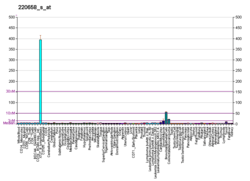ARNTL2
Aryl hydrocarbon receptor nuclear translocator-like 2, also known as Mop9,[5] Bmal2,[6] Clif,[7] or Arntl2, is a gene.
Arntl2 is a paralog to Arntl, which are both homologs of the Drosophila Cycle.[8] Homologs were also isolated in fish,[9] birds[10] and mammals such as mice[11] and humans.[5] Based on phylogenetic analyses, it was proposed that Arntl2 arose from duplication of the Arntl gene early in the vertebrate lineage, followed by rapid divergence of the Arntl gene copy.[11] The protein product of the gene interacts with both CLOCK and NPAS2 to bind to E-box sequences in regulated promoters and activate their transcription.[5] Although Arntl2 is not required for normal function of the mammalian circadian oscillator, it may play an important role in mediating the output of the circadian clock. Perhaps because of this, there is relatively little published literature on the role of Arntl2 in regulation of physiology.
Arntl2 is a candidate gene for human type 1 diabetes.[12]
In over expression studies, ARNTL2 protein forms a heterodimer with CLOCK to regulate E-box sequences in the Pai-1 promoter.[7] Recent work suggest that this interaction may be in concert with ARNTL/CLOCK heterodimeric complexes.[13]
See also
- Arntl (Bmal1)
References
- GRCh38: Ensembl release 89: ENSG00000029153 - Ensembl, May 2017
- GRCm38: Ensembl release 89: ENSMUSG00000040187 - Ensembl, May 2017
- "Human PubMed Reference:". National Center for Biotechnology Information, U.S. National Library of Medicine.
- "Mouse PubMed Reference:". National Center for Biotechnology Information, U.S. National Library of Medicine.
- Hogenesch JB, Gu YZ, Moran SM, Shimomura K, Radcliffe LA, Takahashi JS, Bradfield CA (July 2000). "The basic helix-loop-helix-PAS protein MOP9 is a brain-specific heterodimeric partner of circadian and hypoxia factors". The Journal of Neuroscience. 20 (13): RC83. doi:10.1523/JNEUROSCI.20-13-j0002.2000. PMC 6772280. PMID 10864977.
- Ikeda M, Yu W, Hirai M, Ebisawa T, Honma S, Yoshimura K, Honma KI, Nomura M (August 2000). "cDNA cloning of a novel bHLH-PAS transcription factor superfamily gene, BMAL2: its mRNA expression, subcellular distribution, and chromosomal localization". Biochemical and Biophysical Research Communications. 275 (2): 493–502. doi:10.1006/bbrc.2000.3248. PMID 10964693.
- Maemura K, de la Monte SM, Chin MT, Layne MD, Hsieh CM, Yet SF, Perrella MA, Lee ME (November 2000). "CLIF, a novel cycle-like factor, regulates the circadian oscillation of plasminogen activator inhibitor-1 gene expression". The Journal of Biological Chemistry. 275 (47): 36847–51. doi:10.1074/jbc.C000629200. PMID 11018023.
- Rutila JE, Suri V, Le M, So WV, Rosbash M, Hall JC (May 1998). "CYCLE is a second bHLH-PAS clock protein essential for circadian rhythmicity and transcription of Drosophila period and timeless". Cell. 93 (5): 805–14. doi:10.1016/S0092-8674(00)81441-5. PMID 9630224.
- Cermakian N, Whitmore D, Foulkes NS, Sassone-Corsi P (April 2000). "Asynchronous oscillations of two zebrafish CLOCK partners reveal differential clock control and function". Proceedings of the National Academy of Sciences of the United States of America. 97 (8): 4339–44. doi:10.1073/pnas.97.8.4339. PMC 18243. PMID 10760301.
- Okano T, Yamamoto K, Okano K, Hirota T, Kasahara T, Sasaki M, Takanaka Y, Fukada Y (September 2001). "Chicken pineal clock genes: implication of BMAL2 as a bidirectional regulator in circadian clock oscillation". Genes to Cells. 6 (9): 825–36. doi:10.1046/j.1365-2443.2001.00462.x. PMID 11554928.
- Okano T, Sasaki M, Fukada Y (March 2001). "Cloning of mouse BMAL2 and its daily expression profile in the suprachiasmatic nucleus: a remarkable acceleration of Bmal2 sequence divergence after Bmal gene duplication". Neuroscience Letters. 300 (2): 111–4. doi:10.1016/S0304-3940(01)01581-6. PMID 11207387.
- Hung MS, Avner P, Rogner UC (September 2006). "Identification of the transcription factor ARNTL2 as a candidate gene for the type 1 diabetes locus Idd6". Human Molecular Genetics. 15 (18): 2732–42. doi:10.1093/hmg/ddl209. PMID 16893914.
- Schoenhard JA, Smith LH, Painter CA, Eren M, Johnson CH, Vaughan DE (May 2003). "Regulation of the PAI-1 promoter by circadian clock components: differential activation by BMAL1 and BMAL2". Journal of Molecular and Cellular Cardiology. 35 (5): 473–81. doi:10.1016/S0022-2828(03)00051-8. PMID 12738229.
External links
- ARNTL2+protein,+human at the US National Library of Medicine Medical Subject Headings (MeSH)
- Human ARNTL2 genome location and ARNTL2 gene details page in the UCSC Genome Browser.
- Overview of all the structural information available in the PDB for UniProt: Q8WYA1 (Aryl hydrocarbon receptor nuclear translocator-like protein 2) at the PDBe-KB.




